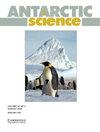Experimental determination of reflectance spectra of Antarctic krill (Euphausia superba) in the Scotia Sea
IF 2
4区 地球科学
Q3 ENVIRONMENTAL SCIENCES
引用次数: 1
Abstract
Abstract Antarctic krill are the dominant metazoan in the Southern Ocean in terms of biomass; however, their wide and patchy distribution means that estimates of their biomass are still uncertain. Most currently employed methods do not sample the upper surface layers, yet historical records indicate that large surface swarms can change the water colour. Ocean colour satellites are able to measure the surface ocean synoptically and should theoretically provide a means for detecting and measuring surface krill swarms. Before we can assess the feasibility of remote detection, more must be known about the reflectance spectra of krill. Here, we measure the reflectance spectral signature of Antarctic krill collected in situ from the Scotia Sea and compare it to that of in situ water. Using a spectroradiometer, we measure a strong absorption feature between 500 and 550 nm, which corresponds to the pigment astaxanthin, and high reflectance in the 600–700 nm range due to the krill's red colouration. We find that the spectra of seawater containing krill is significantly different from seawater only. We conclude that it is tractable to detect high-density swarms of krill remotely using platforms such as optical satellites and unmanned aerial vehicles, and further steps to carry out ground-truthing campaigns are now warranted.斯科舍海南极磷虾反射光谱的实验测定
摘要就生物量而言,南极磷虾是南大洋的主要后生动物;然而,它们广泛而不均匀的分布意味着对其生物量的估计仍然不确定。目前使用的大多数方法都没有对上层表层进行采样,但历史记录表明,大型表层蜂群可以改变水的颜色。海洋彩色卫星能够对海洋表面进行观测,理论上应该为探测和测量表面磷虾群提供一种手段。在我们评估远程探测的可行性之前,必须对磷虾的反射光谱有更多的了解。在这里,我们测量了从斯科舍海原位采集的南极磷虾的反射光谱特征,并将其与原位水的反射光谱信号进行了比较。使用光谱辐射计,我们测量了500至550 nm之间的强吸收特征,这对应于色素虾青素,以及由于磷虾的红色而在600至700 nm范围内的高反射率。我们发现,含有磷虾的海水的光谱与纯海水的光谱有显著差异。我们得出的结论是,使用光学卫星和无人机等平台远程探测高密度磷虾群是容易的,现在有必要采取进一步措施开展地面实况调查活动。
本文章由计算机程序翻译,如有差异,请以英文原文为准。
求助全文
约1分钟内获得全文
求助全文
来源期刊

Antarctic Science
地学-地球科学综合
CiteScore
3.60
自引率
6.20%
发文量
42
审稿时长
3 months
期刊介绍:
Antarctic Science provides a truly international forum for the broad spread of studies that increasingly characterise scientific research in the Antarctic. Whilst emphasising interdisciplinary work, the journal publishes papers from environmental management to biodiversity, from volcanoes to icebergs, and from oceanography to the upper atmosphere. No other journal covers such a wide range of Antarctic scientific studies. The journal attracts papers from all countries currently undertaking Antarctic research. It publishes both review and data papers with no limits on length, two-page short notes on technical developments and recent discoveries, and book reviews. These, together with an editorial discussing broader aspects of science, provide a rich and varied mixture of items to interest researchers in all areas of science. There are no page charges, or charges for colour, to authors publishing in the Journal. One issue each year is normally devoted to a specific theme or papers from a major meeting.
 求助内容:
求助内容: 应助结果提醒方式:
应助结果提醒方式:


